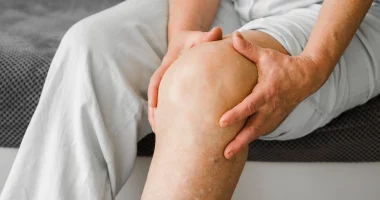Chronic hives is a condition where red, itchy welts, known as urticaria, appear on the skin and last for 6 weeks or more. This disease affects around 1% of the population in the United States.
When the exact cause of these long-lasting hives is unknown, the condition is referred to as chronic idiopathic urticaria, or sometimes as chronic spontaneous urticaria. “Idiopathic” and “spontaneous” mean that the hives occur without a clear reason or trigger.
Symptoms
Chronic hives are characterized by itchy, red welts that appear on the skin. These welts can vary in size and may join together to form larger areas of raised red skin. In some cases, these welts are accompanied by swelling, known as angioedema, which can happen around the lips, eyes, feet, or hands. The itching associated with chronic hives can be intense, leading to discomfort and sometimes even disrupting sleep. Although the symptoms may come and go, they are considered chronic if they persist for a minimum of six weeks.
In addition to itching and welts, chronic urticaria may also cause other symptoms like redness, swelling, and pain. The affected areas of the skin might feel tender or warm to the touch, and the pain can range from mild to severe. The unpredictable nature of these signs can significantly impact an individual’s quality of life, causing physical discomfort and emotional distress. Even when the welts disappear, they may return without warning, making it trouble to predict or control flare-ups.
Causes
Chronic hives can be triggered by various factors, including stress, infections, and autoimmune diseases. Infections typically cause acute hives but can occasionally lead to chronic hives if there is a disruption in immune function. Extreme temperatures, whether heat or cold, can also provoke hives, as can significant emotional stress. Autoimmune diseases, where the immune system mistakenly attacks healthy cells, may contribute to the development of chronic urticaria.
However, in about 95% of cases, the exact cause of chronic hives remains unknown. When the underlying cause cannot be identified, the condition is referred to as chronic spontaneous urticaria or chronic idiopathic urticaria. This means that despite extensive investigation, no specific trigger for the hives can be determined.
Diagnosis
To diagnose chronic hives, a healthcare provider starts by conducting a thorough evaluation, which includes a detailed discussion of the patient’s symptoms and medical history. They will perform a skin examination to assess the appearance and distribution of the hives. Additionally, the provider will work to rule out other potential causes of the hives, like anaphylactic reactions or other underlying conditions.
Chronic hives are diagnosed when hives persist for 6 weeks or more. In contrast, if the hives last less than 6 weeks, they are classified as acute hives. This distinction helps in determining the appropriate treatment and management strategies for the condition.
Treatment
You should seek immediate medical attention if hives are accompanied by difficulty breathing or other symptoms of anaphylaxis. Anaphylaxis is a severe allergic reaction that can be life-threatening and requires prompt treatment to prevent serious complications or even death.
Additionally, it is important to consult a healthcare provider if hives persist beyond a few days, cause significant discomfort, or interfere with your daily activities. Persistent hives that affect your quality of life or contribute to mental health issues, like depression or anxiety, also warrant medical evaluation. Addressing these concerns with a healthcare provider can help manage symptoms effectively and improve overall well-being.
Complications
Chronic hives, while typically not dangerous, can lead to significant discomfort and has the potential for serious complications. One of the most severe complications is anaphylaxis, a life-threatening allergic reaction that affects multiple body systems. Anaphylaxis can cause severe signs like difficulty breathing and ending of the airways. Although anaphylaxis is rare in chronic hives, it is a serious condition that requires immediate medical attention if it occurs.
In addition to physical symptoms, chronic hives can also impact mental health. Living with a persistent condition like chronic hives may lead to increased depression and anxiety due to the ongoing discomfort and stress. The persistent itching and welts can significantly interfere with daily activities, affecting a person’s quality of life. Managing chronic hives often involves addressing both the physical and emotional aspects of the condition to improve overall well-being.
Prevention
Preventing chronic hives involves several strategies to minimize triggers and manage symptoms. Keeping your skin well-moisturized can help maintain its barrier and reduce irritation. It is also advisable to avoid exposure to extreme heat, which can exacerbate hives. If medication is prescribed, taking it as directed can help control symptoms and prevent flare-ups.
If your chronic hives are linked to an autoimmune condition, managing the underlying autoimmune disease is crucial. Effective treatment of the autoimmune disorder can help alleviate associated symptoms, including hives. Additionally, since stress can contribute to the onset and worsening of chronic hives, incorporating regular relaxation and stress relief practices into your routine can be beneficial in preventing hives.
Summary
Chronic hives, characterized by red, itchy welts lasting 6 weeks or more, can be caused by various factors, including infections, stress, and autoimmune diseases. In about 95% of cases, the cause remains unknown, known as chronic idiopathic urticaria. Treatment involves medications to relieve itching and discomfort, along with home remedies like cold compresses. Managing stress and addressing any underlying conditions are also crucial. Immediate medical attention is required if hives are accompanied by difficulty breathing or severe discomfort. Preventative measures include moisturizing the skin, avoiding extreme temperatures, and practicing stress relief.






